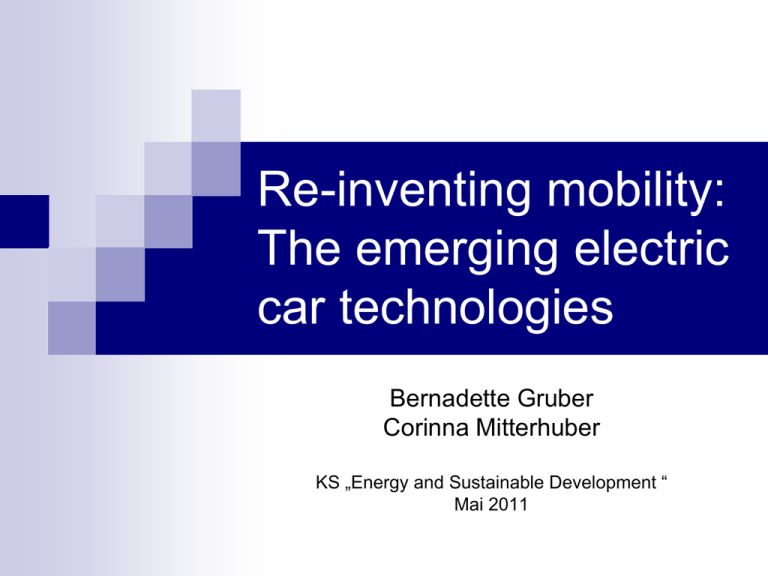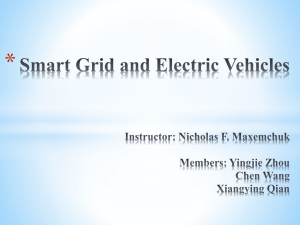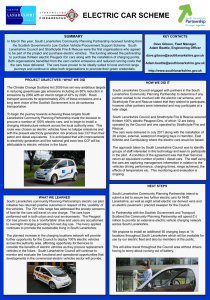Re-inventing mobility: The emerging electric car technologies
advertisement

Re-inventing mobility: The emerging electric car technologies Bernadette Gruber Corinna Mitterhuber KS „Energy and Sustainable Development “ Mai 2011 Contents Historical development of electric cars General concept of electric cars Characteristics of electric car Comparison with a combustion engine Storage systems of electric cars Hybrid propulsion Contents Economic aspects of e-cars Costs and profitability Energy economical aspects of electric cars Market development of electric car technologies Application possibilities for electric vehicles Conclusion & Outlook Historical development of electric cars Early Years of Electric Cars: 1890 - 1930 First electric vehicle invented in 1828 Many innovations followed The interest in electric cars increased greatly in the late 1890s and early 1900s First real and practical electric car (with capacity for passengers) designed by William Morrison 1902 Phaeton built by the Woods Motor Vehicle Company of Chicago Figure: 1902 Wood's Electric Phaeton (Inventors, http://inventors.about.com/od/estartinventions/a/History-Of-Electric-Vehicles.htm, 7.5. 2011). Historical development of electric cars Decline of Electric Cars: 1930 – 1990 The electric car declined in popularity because of the following reasons: Better system of roads need for longer-range vehicles Reduction in price of gasoline gasoline was affordable to the average consumer Invention of the electric starter disposed of the need for the hand crank. Initiation of mass production of internal combustion engine vehicles by Henry Ford. Historical development of electric cars The mid-1930s until the 1960s: dead years for electric vehicle development and for their application as personal transportation In the 1960s and 1970s: imperative necessity for alternative-fueled vehicles renewed interest on electric vehicles The first electric truck, the Battronic Truck, constructed in the early 1960s. The companies Sebring-Vanguard and Elcar Corporation = leaders in the electric car production Historical development of electric cars The Revival: 1990s Efforts by the governments to more stringent air emissions requirements and regulations requiring reductions in gasoline use and Zero Emission Vehicle requirements from several states revival Electric conversions of familiar gasoline powered vehicles as well as electric vehicles designed from the ground up became available (reached highway speeds with ranges of 50 to 150 miles between recharging) Since 2001: Phoenix designs fully functional electric trucks and Sport Utility Vehicle for commercial fleet use Figure: Phoenix Motorcar (Inventors, http://inventors.about.com/od/estartinventions/a/History-OfElectric Vehicles.htm, 7.5. 2011). General concept of electric cars Characteristics of electric cars Core elements: battery, electric motor, plug- in system, differential Efficiency ratio is close to 90 percent needed energy depends on battery (type, age, temperature), the way of charging and the general construction of motor and car itself Maximum power of the motor is reached from standstill, leads to “smooth” way of driving Possibility to use energy of break application to refeed it into battery General concept of electric cars Comparison with a combustion engine powered car Providing energy: Efficiency ratio: Electric motor: close to 90 percent E-cars get energy out of battery Conventional car gets energy out of combustion engine Combustion engine: 25-30 percent In case of e-car mature efficiency losses occur during electricity production General concept of electric cars Comparison with a combustion engine powered car Emissions: E-car: Occur during electricity production; positive for e.g fine dust Combustion engine: emissions occur during driving Electric cars produce much less noise than combustion engine powered cars Electric cars have no gearbox General concept of electric cars Combustion engine powered car: Electric car: Figure: Coparison convential car/ electric car (Electrification Coalition 2009) Fuel system is on the back side, where it transmits power to the gearbox, which powers the wheels Battery is stored at back side, where it transmits the energy to the electric motor which powers the wheels General concept of electric cars Storage systems for electric cars Lead acid batteries Nickel cadmium batteries Inferior to new technologies due to low energy density and high toxicity Nickel metal hydride batteries no essential role for powering electric vehicles Very high energy density, good efficiency-to- size-ratio, very long lasting and unproblematic in terms of safety BUT very high price for raw materials Lithium ion batteries General concept of electric cars Lithium ion batteries: most promising storage technology for electric vehicles Advantages: Highest energy density of all battery systems operating at room temperature lower number of cells needed 20-30 percent lighter than nickel cadmium batteries No memory effect Disadvantages: In case of destruction toxic gases and flammable material can occur Very expensive General concept of electric cars Hybrid propulsion: Combination technology between combustion engine and electric engine In parallel hybrid systems both engines power the shaft In series hybrid systems the combustion engine is powering a generator which transmits energy to the electric motor In combined hybrid systems one can change between parallel and series propulsion General concept of electric cars Hybrid propulsion Hybrid-electric vehicle: Figure: Hybrid-electric-vehicle (Electrification Coalition 2009) Either parallel, series or combined system Contains liquid fuel tank and battery No plug-in system for charging the battery external General concept of electric cars Hybrid propulsion Plug-in hybrid vehicle: Figure: Plug-in hybrid electric vehicle (Electrification Coalition 2009) Either series or combined system Contains an on-board generator Possible to run as sole electric vehicle through plug-in for external charging of battery Economic aspects of e-cars Costs and profitability: Electric vehicles of the middle class with range of about 150 km: 10,000 to 15,000 euro Very low operating costs Daimler: sells its future e-cars quickly profitably hopes for a start-up funding from the Federal Government In many countries: purchase of e-cars remunerated by subsidies Figures: Costs of vehicles (2010 and 2030) (Kloess et al., 2009: 4,5) Economic aspects of e-cars Energy economical aspects of e-cars: Construction of a corresponding charging infrastructure (charging stations) In Austria: 2,600 electric service stations (May 2010) To recharge 15 to 20 kWh, which a small car on 100 kilometres requires, lasts via a normal household outlet from six to eight hours. Figure: Uniform charging connector (Mennekes, http://www.mennekes.de/web, 10.05.2011). Figure : Charging station for electric cars (Mennekes, http://www.mennekes.de/web/, 10.05.2011). Economic aspects of e-cars The electric propulsion: efficiency = about 90% Electric propulsion is principally as "clean" as the energy source A photovoltaics-carport (solar service station) considered as a charging station of electric cars for the future Figure :Photovoltaics-carport as a charging station of electric cars (Das Photovoltaik Portal, http://www.photovoltaiko.de/, 09.05.2011). Economic aspects of e-cars Market development of electric car technologies: Market for e-cars still depend on direct subsidies, tax subsidizations or on clearly higher fuel prices According to the most probable scenario: in 2020 26 % of new cars in China, Japan, the USA and Western Europe could have electric or hybrid propulsion Challenges for the electric car market: energy storage capacities, recharge times, infrastructure requirements, costs of the batteries,… Without any technological breakthrough: the range of an electric car will furthermore amount to only 250 to 300 km. At the present time: automotive corporations cooperate closely with manufacturers of electric car batteries Economic aspects of e-cars In 2009: global electric vehicle market = more than 26 billion dollars worth & probably grows at a compound annual growth rate (CAGR) of 18.5% between 2010 and 2015 The plug-in hybrid electric vehicles-segment probably increase at a CAGR of 81.6% The hybrid electric vehicles market: CAGR of 19.1% Figure: Summary figure – electric vehicle shipments and value by configuration from 2005 to 2015 (Concensus scenario) (in $ Millions) (Bcc Research, http://www.bccresearch.com/report/electric-vehiclespower-sources-fcb019d.html, 11.05.2011). Application possibilities for electric vehicles The development of electric cars or vehicles can be divided broadly in the following directions or trends: Industrial vehicles Figure: Mafi- electric load cart at Daimler-Chrysler (Schnitzler, http://de.factolex.com/Elektrokarren, 30.4.2011) Application possibilities for electric vehicles Development of new passenger cars: Urban vehicles Figure: CityEL (Firma Haberhauer, http://www.elektromobilcenter.com/, 30.4.2011) Electric vehicles suited for highway Figure : Think City (Stegmann, http://www.motorkultur.com/de/home/visionen/13artikel/4929-elektroauto-think-eine-erfolgsstory.html, 30.4.2011) Application possibilities for electric vehicles Alteration from customary cars to electric vehicles Figure: Renault Twingo Electra (MobiLEM, http://www.mobilem.ch/fahrzeuge/fahrz main.htm, 30.4.2011) Study vehicles and experimental vehicles Figure: Keio University Eliica (Deep Dive Media Automotive Network, http://www.futurecars.com/futurecars/electric-cars/eliica-8-wheel-electrictears-it-up-one-wheel-at-a-time, 30.4.2011) Conclusion & Outlook Huge potential for the further emerging of electric cars Although there are still problems, it is important to push this technology R&D Electrical outlet and electric cable are not required in future anymore, because the electric car of the future "refuels" its power fully automatically and without contacting by induction while driving or parking. Figure: Power from the street. The electric car of the future "refuels" its power fully automatically and without contacting by induction while driving or parking. (Glocalist, http://www.glocalist.com/news/kategorie/vermischtes/titel/daselektroauto-der-zukunft-tankt-beim-fahren/, 07.05.2011) Videos A brief history of the electric car Adaptera Exclusive- 3 wheeled electric wonder on the road Thank you for your attention!











